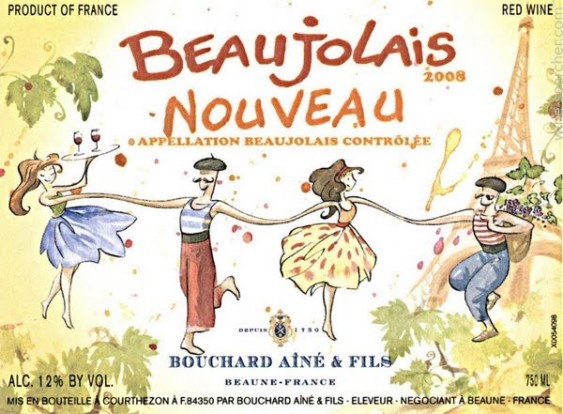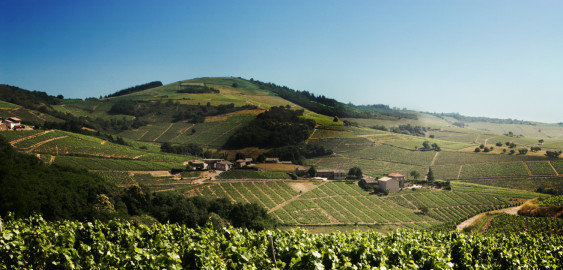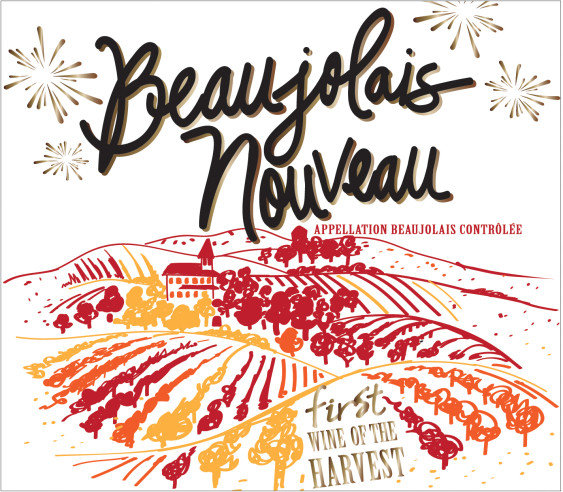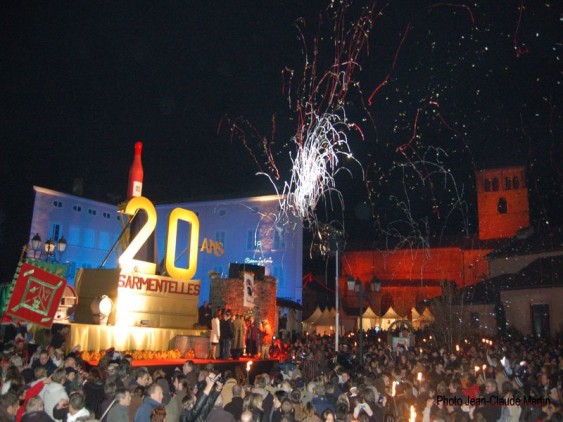This Thursday, November 19, marks Beaujolais Nouveau Day for 2015, and I can’t let a wine-inspired holiday go by without a little bit of explanation.

Get ready for Beaujolais Nouveau! Photo source: Bouchard.
When it comes to French wines, and especially reds, it’s common wisdom that at a certain quality level, the older the wine, the better it’s likely to be. Obviously there are many, many exceptions, and one of the most famous is Beaujolais Nouveau.
Beaujolais is a region just to the south of Burgundy that produces red wines made from Gamay grapes. They tend to be lighter-bodied than Burgundies with a different flavor profile that often includes hints of redcurrant, cranberry, cherry, and perhaps banana or fig. Basically, fresh fruit flavors with none of those chocolatey-mocha flavors you get in some older barrel-aged wines.
As the name suggests, Beaujolais Nouveau is, well, new Beaujolais. It is a vin primeur, or a wine that is sold in the same year in which it is harvested. What really sets Beaujolais Nouveau apart from other French reds, though, is that it is fermented for just a few weeks, then bottled and then shipped directly to market on the third Thursday of November, which is now known as Beaujolais Nouveau Day.

Beaujolais is just south of Burgundy, but its wines are quite different. Photo source: Vins du Beaujolais.
As you can imagine, that’s quite unusual in a country known for aging its wines, especially thanks to the fact that it produces some of the world’s best (and certainly its most expensive) oak barrels specifically for aging wines.
There are also a few other rules by which these wines must abide. Those labeled as Beaujolais Nouveau must be hand-harvested (it’s mandatory) and cannot be made from grapes grown in Beaujolais’ 10 great crus areas (if they are, they have to be designated as one of those). The wines are made by carbonic maceration, meaning the grapes are kept in an anaerobic (oxygen-free) environment, and ferment spontaneously within their own skins rather than being crushed and letting the juice run outside the skins and ferment that way. This results in more fruity-flavored wines with lower tannin levels…so you don’t really want to age them too long anyway. I’ll get into that in later posts.
It wasn’t always this way. The whole thing started as a harvest celebration with the new wine, and usually the low-level stuff that was going to be sold cheaply anyway, just being consumed locally. But it made a lot of sense for winemakers. They could get rid of a lot of their table-quality wine quickly and thus get a little cash flow as well as freeing up storage space. In the 1930s, winemakers in Beaujolais could release wines as early as December 15, and then that was pushed up even earlier in the 1950s.

Look for fun labels celebrating the release. Photo source: Georges DuBoeuf.
Eventually, the release of Beaujolais became so popular there was even a race to Paris of the first bottles of the new vintage each year, but that was more of a marketing ploy. Though the hype has died down over the years, there are still literally over 100 festivities celebrating the release annually. The most famous is called the Fête des Sarmentelles (festival of the grape cuttings) and is held over several days in the Beaujolais capital of Beaujeu. The festivities include torch-lit parades, the ceremonial tapping of new barrels, performances, and a wine-tasting competition whose winner traditionally takes home the prize of his or her weight in wine.

If you win the wine-tasting contest at Les Sarmentelles, you get to take home your weight in wine. Photo source: Sarmentelles.
These days, nearly half of the grapes grown in Beaujolais are allocated for Beaujolais Nouveau, while the other half are aged more like other French wines for a few years. That’s despite the fact that Beaujolais Nouveau was pretty much lambasted by critics for a good decade or two thanks to the simplicity of the wines and their style as well as the over-marketing of them as the perfect accompaniment to Thanksgiving dinner.
It’s true – because they’re fresher but less full-bodied than some other reds, Beaujolais Nouveau tends to be a nice, light, food-friendly accompaniment to the big meal. But you still have a lot of other choices if you don’t want to drink Beaujolais Nouveau all night. One of the best things about Beaujolais Nouveau is its price point, with many bottles in the $10-and-under range, and some great finds clocking in at just $15, so you can try a few bottles without breaking the bank, and decide if it’s what you want to drink with Thanksgiving.
I’m also a firm believer that every wine has its place, including Beaujolais Nouveau, and apart from the Thanksgiving debate, I love its nimbleness and fruit-driven nature, which makes for a nice change from sometimes-tannic French wines. You can serve it slightly chilled, which makes it even more refreshing. Especially for those evenings when you just don’t want a big, bold red.
Think of it this way. If France’s red wines were dances, Bordeaux would be tango – brash and sensual but also sometimes rigid and aloof. Burgundy would be like ballet – carefully calibrated, sinuous and sometimes inaccessible. Beaujolais, on the other hand, would be the Charleston – celebratory, energetic and fun. Just the thing for a night out on the town.
I’m putting my dancing shoes on.

